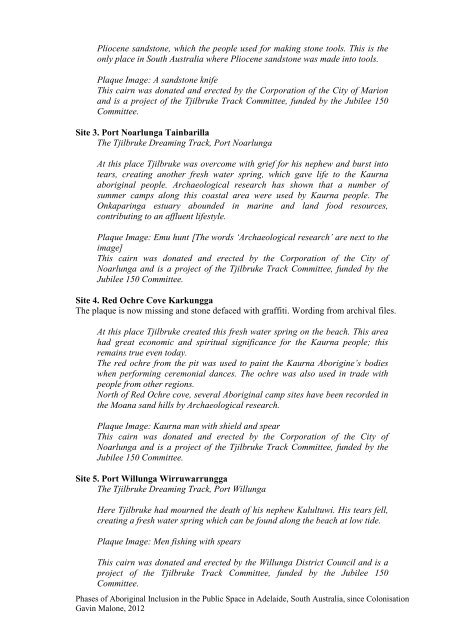<strong>Appendix</strong> ETjilbruke Dreaming Track Plaques, Jubilee 150, 1986.Wording on PlaquesSite 1. Hallett Cove Karildilla, Weerab DriveWeerab Drive, Aboriginal Significant SiteDue to anthropological and archaeological research. [sic] It was discoveredthat the spring at the bottom end <strong>of</strong> this reserve was a major source, whichsupplied the numerous campsites <strong>of</strong> the (KAURNA) Aboriginal people <strong>of</strong> theAdelaide Plains, with fresh water in the immediate area.Some <strong>of</strong> the camp sites date back more than 6,000 years.Plaque Image: Aboriginal campsiteThis cairn was donated and erected by the Corporation <strong>of</strong> the City <strong>of</strong> Marionand is a project <strong>of</strong> the Tjilbruke Track Committee, funded by the Jubilee 150Committee.The proposed wording for Site 1 at Kingston Park, adjacent to the Tjilbruke Monument,would have given an introduction to the narrative.Site 1 Kingston ParkThis landmark is a reminder <strong>of</strong> the Kaurna Aborigines <strong>of</strong> the Adelaide Plains.It represents the creator hero Tjilbruke with the body <strong>of</strong> his nephew, Kulultuwi,who was slain for killing an emu against tribal law. Tjilbruke carried hisnephew in mourning along the coast to Cape Jervis, where he displayed thebody to the spirits <strong>of</strong> the dead on Kangaroo Island. At each <strong>of</strong> his camps on theway, his tears became the springs and water holes <strong>of</strong> the Kaurna coastalhunting grounds. The body <strong>of</strong> Kulultuwi was later lodged in a cave near RapidBay.Unveiled by His Excellency, the Governor <strong>of</strong> South Australia, Sir MarkOliphant, K.B.E. on the 24th September, 1972. This monument was raised bypublic subscription under the sponsorship <strong>of</strong> the South Australian Museum, theSunday Mail and Aboriginal Community <strong>of</strong> this state.Sculptor–John DowieSite 2. Hallett Cove Karildilla, foreshore, Heron WayThe Tjilbruke Dreaming Track, Hallett CoveThe coastal area along Hallett Cove was <strong>of</strong> major cultural and mythologicalsignificance to the Kaurna Aborigines. It was on this beach that Tjilbrukecreated a fresh water spring which he gave to the people. The presence <strong>of</strong>permanent springs enabled the semi nomadic Kaurna to establish their summercamp-sites in this area. Fish, shellfish and crustaceans were the major foodsource.Archaeological surveys have unearthed numerous campsites, some <strong>of</strong> whichdate back 6,000 years. Of particular archaeological significance is an area <strong>of</strong>Phases <strong>of</strong> Aboriginal Inclusion in the Public Space in Adelaide, South Australia, since ColonisationGavin Malone, 2012
Pliocene sandstone, which the people used for making stone tools. This is theonly place in South Australia where Pliocene sandstone was made into tools.Plaque Image: A sandstone knifeThis cairn was donated and erected by the Corporation <strong>of</strong> the City <strong>of</strong> Marionand is a project <strong>of</strong> the Tjilbruke Track Committee, funded by the Jubilee 150Committee.Site 3. Port Noarlunga TainbarillaThe Tjilbruke Dreaming Track, Port NoarlungaAt this place Tjilbruke was overcome with grief for his nephew and burst intotears, creating another fresh water spring, which gave life to the Kaurnaaboriginal people. Archaeological research has shown that a number <strong>of</strong>summer camps along this coastal area were used by Kaurna people. TheOnkaparinga estuary abounded in marine and land food resources,contributing to an affluent lifestyle.Plaque Image: Emu hunt [The words ‘Archaeological research’ are next to theimage]This cairn was donated and erected by the Corporation <strong>of</strong> the City <strong>of</strong>Noarlunga and is a project <strong>of</strong> the Tjilbruke Track Committee, funded by theJubilee 150 Committee.Site 4. Red Ochre Cove KarkunggaThe plaque is now missing and stone defaced with graffiti. Wording from archival files.At this place Tjilbruke created this fresh water spring on the beach. This areahad great economic and spiritual significance for the Kaurna people; thisremains true even today.The red ochre from the pit was used to paint the Kaurna Aborigine’s bodieswhen performing ceremonial dances. The ochre was also used in trade withpeople from other regions.North <strong>of</strong> Red Ochre cove, several Aboriginal camp sites have been recorded inthe Moana sand hills by Archaeological research.Plaque Image: Kaurna man with shield and spearThis cairn was donated and erected by the Corporation <strong>of</strong> the City <strong>of</strong>Noarlunga and is a project <strong>of</strong> the Tjilbruke Track Committee, funded by theJubilee 150 Committee.Site 5. Port Willunga WirruwarrunggaThe Tjilbruke Dreaming Track, Port WillungaHere Tjilbruke had mourned the death <strong>of</strong> his nephew Kulultuwi. His tears fell,creating a fresh water spring which can be found along the beach at low tide.Plaque Image: Men fishing with spearsThis cairn was donated and erected by the Willunga District Council and is aproject <strong>of</strong> the Tjilbruke Track Committee, funded by the Jubilee 150Committee.Phases <strong>of</strong> Aboriginal Inclusion in the Public Space in Adelaide, South Australia, since ColonisationGavin Malone, 2012
- Page 1 and 2: Appendix AWays of BelongingReconcil
- Page 4 and 5: John Dowie had already done somethi
- Page 6 and 7: Appendix BAdelaide’s Aboriginal C
- Page 8 and 9: Foyer, Tea Tree Gully Community Hea
- Page 10 and 11: Figure 2 Mural, 1995, Bowden Brompt
- Page 12 and 13: Figure 8 Mural, 1990s, Torrensville
- Page 14 and 15: Figure 14 Mural - Mosaic, 2002, Ent
- Page 16 and 17: Figure 20 Mural, 2008, Elizabeth So
- Page 18 and 19: 2002 Tappa Wodliparri Trail (vandal
- Page 22 and 23: Site 6. Sellicks Beach WitawodliThe
- Page 25 and 26: ON 01 1965 Rainmakers Lohmann Park,















